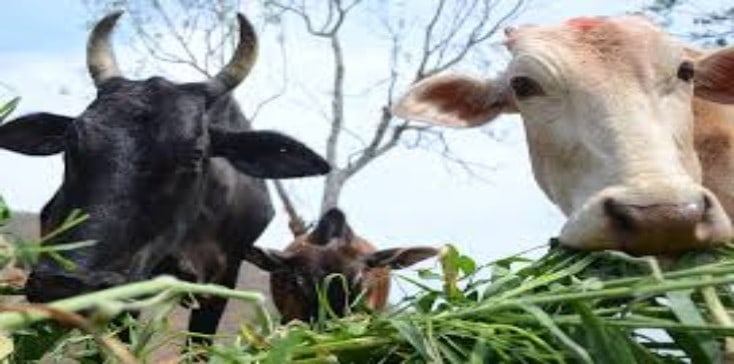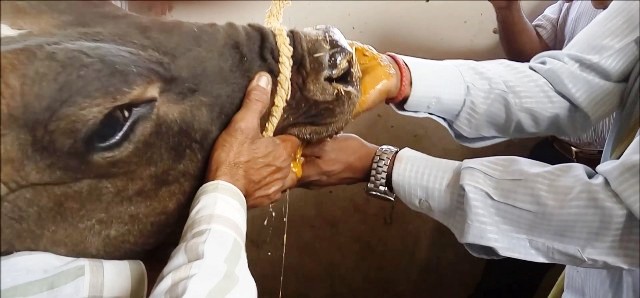
Foot and Mouth Disease in Dairy Cows
Foot and Mouth Disease is a severe, highly contagious viral disease-causing economic losses to the farmers. The disease is common in crossbred cattle whereas the native breeds of cattle suffer only mild disease. The same disease can also occur in swine, sheep, goat, and other hooved animals. Cows maintained in intensive farms and gaushala are more susceptible to the disease. Although not fatal in adult animals, but in the case of lactating animals the loss of milk and fertility is quite severe.
In the case of crossbred calves, the disease sometimes is fatal due to heart involvement. The disease spreads very fast once the first case is recorded in a village. In certain areas, the disease occurs whenever there is a large-scale movement of animals from non-protected areas to the vaccinated areas. During the time of outbreaks, biosecurity is very important. Even a mild disease in vaccinated animals might also result in a loss in milk production, abortion, and loss of fertility.
Clinical Signs
The disease starts with very high fever (105 to 106 0F), the animal starts salivating profusely and high fever leads to respiratory distress, dehydration and loss of condition. Blisters appear on lips and tongue, teat, and hooves. The hoof lesions lead to lameness. In the case of intensive farms, many animals will produce reduced milk production even if not showing any signs. In such a situation when many animals have produced less milk the farmer should get alert and he should check the animals for health, such as fever and other lesions. Although the mortality in adults is very rare after recovery the animal becomes very weak, remains unproductive for a long time and turns a repeat-breeder.

The disease is caused by a tiny virus and in India, various strains, such as, A, O, C, Asia1, and minor variants, such as A22 have been recorded.
It is notifiable disease hence the first thing farmer should do is inform the nearest veterinarian
Informing the nearest veterinarian is important as the Government will undertake an investigation to confirm the disease and also the type, so that effective vaccination can be undertaken. It is the larger interest of the farmers to inform the veterinarian.
How the Disease is transmitted
The virus is found in all excretions and secretions from the infected animals, especially animals breathe out a large amount of aerosolized virus, which can infect other animals via the respiratory or oral routes. The virus may also be present in milk and semen for up to 4 days before the animal shows clinical signs of disease. One infected animal introduced in the herd can infect the entire herd. The virus is also carried in contaminated pens/buildings or transport vehicles, feed, water, milk. Persons working in the farm are the main carriers of infection as it can contaminate clothing, eyelashes, a person’s hands and body, footwear, and equipment. During the outbreaks, the inseminators or veterinarians should take adequate precautions to sanitize in case they have examined an infected animal. The infected animals can shed virus for a long time.
Not a Zoonotic Disease
There were earlier reports suspecting Foot and Mouth Disease (FMD) to cause conjunctivitis in human but it is generally regarded as of no zoonotic disease importance.
Diagnosis of Foot and Mouth Disease
The symptoms are so classical that most of the farmers will not miss the diagnosis. But, getting confirmation on the type is important. There are other few diseases having similar symptoms, such as vesicular stomatitis and in such cases, the veterinarian will help. In general, high fever, depression, excessive salivation, raised lesions with fluid or burst lesions showing eroded mucous membrane in the oral cavity or foot lesions indicates Foot and Mouth Disease (FMD).
In many cases, there is severe hyperglycaemiaHigh glucose level in blood (blood glucose level of more than 200 mg/dl). If hyperglycaemia is persistent insulin can be administered under the supervision of a qualified veterinarian.
Treatment: Isolate the infected case before the start of the treatment. Since it is viral infection, there is no specific treatment. To oral lesions, boric acid and glycerine can be applied. Washing the mouth with an alkaline solution helps in killing the virus. If this is not available turmeric mixed with ghee can be applied to the wound. Foot lesions require special care as else these develop maggot in deep wound causing severe lameness.
If the temperature is very high antipyretic and analgesic can be administered. There is no need to give an antibiotic. In dehydrated animals’ isotonic saline can be given. Care be given on feeding as due to mouth lesions animal is not able to eat roughage. Soft succulent green grass or silage feeding is helpful.
Prevention and Control:
Measures to be taken at the farm and the village level: control over people’s access to livestock and equipment;
Once a case of Foot and Mouth Disease (FMD) in a farm or a village is identified all villagers should be informed about biosecurity measures to be taken.
- Don not take animals for grazing
- Restrict entry of other farmers and persons near your animals
- In the case of big farms, the laborers should be asked to take a bath and change clothes before entering the farm
- All infected animals should be isolated and attended by separate persons.
- In the case of a village, a common quarantine facility for such cases be created and affected animals should be isolated there.
- The farm premises should be disinfected with contact viricidal chemicals, such as Dettol. Savlon, Lysol, etc.
Vaccination
Since an effective vaccine is available, this could be adopted as a major strategy for control. In case there is an outbreak in the area (and not the farm or village), even if animals have been earlier vaccinated, a booster vaccination is advisable. Ensure that the animals are not in the incubation period. In suspected cases rectal body temperature is indicative.
Regular vaccination: Most of the state governments have an FMD control program. The farmers should follow the vaccination schedule prescribed by each government. The crossbred calves should receive the first vaccination when aged 3 months. Earlier vaccinations may not be effective due to maternal antibodies (which is stronger in case the mother has received vaccination). At least first- three vaccinations should be done every six months and then a booster every year. Whenever there is an outbreak in the vicinity booster should be given. It is, therefore, necessary to maintain vaccines in the stock all the time.
- Whenever a new animal is purchased and introduced on the farm or the village, it must receive FMD vaccination after arrival.
- Individual animal vaccination will prevent severe disease in that animal but vaccinating all the animals on the farm or in the village will eliminate infection from the herd or the village.
- Try vaccinating all the animals in the farm/village on the same day or within 2 days and every new animal entering the farm or the village to be vaccinated. This strategy if adopted in each village will eliminate Foot and Mouth Disease (FMD) from the area within three years.
Post FMD complications
Many crossbred and purebred animals show post FMD complications, such as irregular patterns of hair growth, panting, infertility. This is due to hormone problems (especially the thyroid, pituitary, and pancreas). There is however no treatment. Better cull such animals.
Read: Tick Infestation in Cattle And Its Control – An Overview
